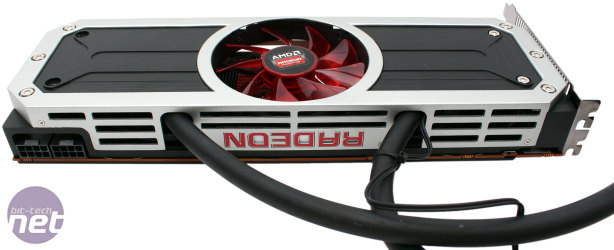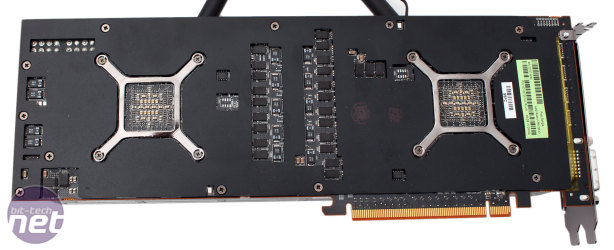Performance Analysis
AMD made clear that 1080p and 1440p resolutions aren't what this card targets, and our tests show that's quite clearly the case. Even so, 1,920 x 1,080 performance is insane, as it averages over 100fps in every test. It's at least 45 percent quicker than the GTX Titan Black and at least 65 percent faster than the R9 290X when it comes to minimum frame rates too. Meanwhile, at 2,560 x 1,440, the R9 295X2 never dips below 60fps in any game, and it's the first single card that can lay claim to this. As things are more GPU limited at this higher resolution, its lead over the GTX Titan Black and R9 290X increases as the pair of GPUs are utilised more fully. For example, it's now 70 percent quicker than Nvidia's best in Battlefield 4, and is effectively twice as quick as a single R9 290X in BioShock Infinite.What the R9 295X2 is really made for are ultra high resolutions, such as triple 1080p Eyefinity set-ups (5,760 x 1,080) and 4K, the equivalent of four 1080p panels. In the triple screen tests, it's clearly the fastest card. In Battlefield 4, no card yet has managed to maintain even 30fps, but the R9 295X2 manages 48fps and averages 60fps, even with 4 x AA enabled. It's a similar story in Crysis 3, where the R9 295X2 hits 42fps minimum while the next best manages just 24fps. In BioShock, it's even closer to 60fps and is again almost 100 percent quicker than a single R9 290X. In Skyrim at this resolution, it's still the fastest card, though it does appear to have some driver limitations, since it's actually faster still at 4K, where 33 percent more pixels are produced. Either way, it's an excellent multi-monitor gaming card.
That leaves us with the 4K tests. When the R9 290X first launched it was said to be designed for 4K, but we found that when using high settings it struggled, even though we disable anti-aliasing, and this is also the case with the highest end single GPU cards from Nvidia. Now, however, we finally have a card that can be considered playable across the board at 4K. It's worst result at this resolution is 34fps in the massively demanding Crysis 3. The experience is easily smooth enough to play, and it also happens to be a result that is exactly double what the R9 290X achieves – scaling really is excellent at this resolution. Battlefield 4 and BioShock are even smoother, as the card maintains over 50fps in both, while Skyrim is simply child's play.
In Unigine Valley, the R9 295X2 is 44 percent quicker than GTX Titan Black and over 80 percent faster than the R9 290X with a monster score of 4,313 at 2,560 x 1,440. Scaling over the R9 290X falls to just 40 percent at 1080p, but the score of 5,528 is still huge.
As you might have expected, power consumption is rather massive. We saw our system drawing 665W in our stress test – the 500W TDP of the card certainly isn't an exaggeration, and this result means our system was drawing 256W more power than with a single R9 290X, precisely what you'd expect. Ensuring your PSU is up to the task with this card is very important.
We initially thought the thermal results were truly fantastic, as the R9 295X2 managed a delta T of just 35°C, which is 6°C less than even a GTX 750 Ti. However, from what we've gathered, the target temperature in the Catalyst Control Centre, as well as the temperature it reports, refers to the liquid temperature within the loop, as opposed to the absolute GPU temperature. As with normal water cooling, the coolant temperature is usually much lower than than a CPU or GPU in a water-cooling loop, so the comparisons to other cards are not necessarily fair. At the time of testing, GPU-Z and other monitoring software were unable to provide us with individual GPU temperatures, so this is the best we have for now. Nevertheless, the card's cooler was still clearly doing its job well, as the liquid temperature never even reached 60°C, and the card remained rock solid at 1,018MHz, indicating that it was not thermal throttling at all.
Even better is the noise output. We were expecting the card's fans to get pretty noisy in our stress tests, but on the contrary both remained very quiet. While you will be able to hear the card, it's not loud, and it's blissful compared to the R9 290X stock cooler.
Given its impressive performance, the R9 295X2 was effectively competing only against itself when overclocked. Nevertheless, we managed a 12 percent performance increase in Battlefield 4 and 9 percent in Crysis 3 (both at 4K), while in Unigine (at just 1440p) the gain was only 8 percent. These aren't massive gains, but equally temperature and noise were essentially unaffected, though system power consumption did increase to 732W.

MSI MPG Velox 100R Chassis Review
October 14 2021 | 15:04












Want to comment? Please log in.